Related Research Articles

A sampler is an electronic musical instrument that records and plays back samples. Samples may comprise elements such as rhythm, melody, speech, sound effects or longer portions of music.
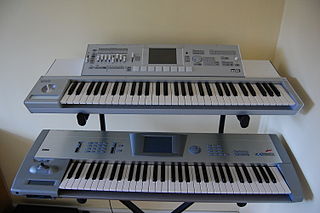
The Korg Triton is a music workstation synthesizer, featuring digital sampling and sequencing, released in 1999. It uses Korg's "HI Synthesis" system and was eventually available in several model variants with numerous upgrade options. The Triton became renowned as a benchmark of keyboard technology, and has been widely featured in music videos and live concerts. At the NAMM Show in 2007, Korg announced the Korg M3 as its successor.

The Emulator is a series of digital sampling synthesizers using floppy-disk storage that was manufactured by E-mu Systems from 1981 until 2002. Although it was not the first commercial sampler, the Emulator was innovative in its integration of computer technology and was among the first samplers to find widespread usage among musicians. While costly, its price was considerably lower than those of its early competitors, and its smaller size increased its portability and, resultantly, practicality for live performance. The line was discontinued in 2002.
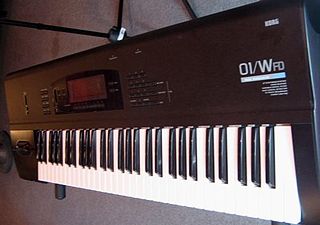
The Korg 01/W series are workstation synthesizers, the first of which debuted in 1991, and were intended to replace the M1 and T series. The workstation/ROMpler was based on AI², an improved version of the AI Synthesis technology found in the M1. The success of the AI² architecture ensured it was used in the majority of subsequent Korg synths of the 1990s.

The Korg Trinity is a synthesizer music workstation released by Korg in 1995. It was also the first workstation to offer modular expansion for not only sounds, but also studio-grade feature such as ADAT, various sound engine processors, audio recording capability, and more. It was considered one of the most comprehensive music workstations, in term of features, at the time.

Palm Products GmbH was a manufacturer of audio synthesizers. Founded and owned by Wolfgang Palm, PPG was located in Hamburg, Germany and, for 12 years from around 1975 to 1987, manufactured an acclaimed and eclectic range of electronic musical instruments, all designed by Palm.
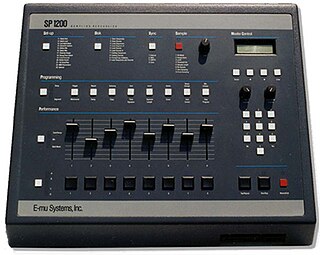
The E-mu SP-1200 is a sampler created by Dave Rossum that was released in August 1987 by E-mu Systems.

The Roland U-20 is a PCM-sample synthesizer, released by Roland in 1989.It was the keyboard version of the U-220 rack module, which was in turn a similar follow-up product to Roland's U-110 rack module of 1988.

Yamaha SY77 is a 16 voice multitimbral music workstation first produced by Yamaha Corporation in 1989. The SY77 is a synthesizer whose architecture combines AFM synthesis, AWM2 for ROM-borne sample-based synthesis, and the combination of these two methods christened Realtime Convolution and Modulation Synthesis (RCM). The same technology was also packaged in a rack-mounted module released simultaneously, the TG77.
The Yamaha SY99 is a synthesiser combining frequency modulation synthesis and sample-based synthesis and the direct successor to Yamaha's SY77/TG77. Compared to the SY77, it has a larger keyboard at 76 keys instead of 61, a larger ROM with more in-built AWM samples, the ability to load user-specified AWM samples into on-board RAM, an upgraded effects processor, and several other enhanced features.
The Roland U-110 is a ROMpler synthesizer module that was produced by Roland Corporation in 1988.

The Studio 440 was a sampler, sequencer, and 32 sound drum machine manufactured by Dave Smith's Sequential Circuits (SCI) and released in 1986. The sampler's core is similar to that of the Prophet 2000 and Prophet 2002. There is a 3.5" floppy disk drive to store samples and data.
The Roland D2 Groovebox is a performance-oriented Groovebox. It has Roland's D-Field Controller technology. It has all of the Roland MC-505 sounds and a similar sequencer. All of the MFX effects have sub-menus. The D2 has 100+ sub-menus to sub-sub-sub-menus, and this is why it has fewer buttons than other Grooveboxes.

The Roland S-50 is a 61-key 12-bit sampler keyboard produced by the Roland Corporation in 1986. It featured a 3.5-inch DSDD floppy disk drive and had external CRT monitor support to facilitate editing of samples. It could hold up to 32 samples. A rack-mounted version was also available, which featured expanded memory.
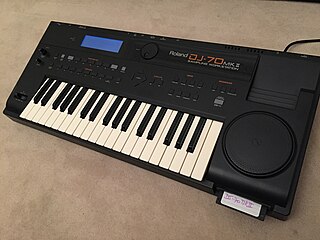
The Roland DJ-70 is a 16-bit linear A/D Conversion & 20-bit linear D/A Conversion sampling workstation and was released in 1992 by Roland Italy.
The Akai X7000 is a 61 key sampling keyboard from Akai. It was released in 1986 and one of the first major samplers released by Akai. It was a 12 bit sampler with 6 voices of polyphony, and included functions such as sample tuning, truncating, reversing and looping. The unit features both microphone and line inputs, and a one line, 16 character LCD screen. For storage, the X7000 uses 2.8" Quick Disks to maintain backwards compatibility with the S612.
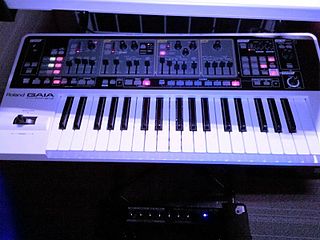
The SH-01 Gaia, is a sixty four voice polyphonic virtual analogue synthesizer introduced by Roland Corporation in 2010.
The Korg Collection 4 is one of the largest collections of VST instruments from Korg and was released in 2004 with updates and more Synths added over time. The original 2004 release consists of the Korg MS-20, Korg Polysix and Korg Wavestation, and LegacyCell, a VST which layers combinations of any of the past 3 synths mentioned. In 2006, they added the Korg Mono/Poly, Korg M1, and Korg MDE-X Multi FX processor. On December 21, 2017, the ARP Odyssey was made into a VST and added to the collection, and the Korg Triton was added on for Christmas 2019. All of these synths were revamped in the spring of 2020 and renamed, collectively, the Korg Collection 2. With the addition of the Korg Triton Extreme, MiniKORG 700s and Korg Prophecy, it was renamed the Korg Collection 3.
The Roland SP-808 GrooveSampler and SP-808EX/E-Mix Studio are both discontinued workstations, which function as digital samplers, synthesizers, and music sequencers. The digital samplers are a part of the long line of both Roland Corporation's and Boss Corporation's Groove Gear, which includes the more popular and successful Boss SP-303 and Roland SP-404 versions.
The Boss Dr. Sample SP-202 is a discontinued sampling workstation made by Boss Corporation, a division under Roland Corporation. Released in the year of 1998, it is the premier installment to the SP family, which includes Boss’s popular SP-303 and Roland's SP-404 installments. The sampler is also successor to Roland's MS-1 Digital Sampler.
References
- ↑ "Roland S-10 | Vintage Synth Explorer". www.vintagesynth.com.
- ↑ Colbeck, Julian. "Mu:zines:Roland S-10 Sampling Keyboard".
- ↑ Inc, Nielsen Business Media (8 February 1986). Billboard. Nielsen Business Media, Inc. – via Google Books.
{{cite book}}:|last1=has generic name (help) - ↑ "Vintage Synth Explorer: Roland S-220". www.vintagesynth.com.